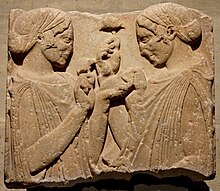

A peplos (Greek: ὁ πέπλος) is a body-length garment established as typical attire for women in ancient Greece by c. 500 BC, during the late Archaic and Classical period. It was a long, rectangular cloth with the top edge folded down about halfway, so that what was the top of the rectangle was now draped below the waist, and the bottom of the rectangle was at the ankle. One side of the peplos could be left open, or pinned or sewn together,[1] with a type of brooch later called "fibula".[2] In Latin and in a Roman context, it could be called a palla.[3]
It should not be confused with the Ionic chiton, which was a piece of fabric folded over and sewn together along the longer side to form a tube. The Classical garment is represented in Greek vase painting from the 5th century BC and in the metopes of temples in the Doric order.
Spartan women continued to wear the peplos much later in history than other Greek cultures. It was also shorter and with slits on the side causing other Greeks to call them phainomērídes (φαινομηρίδες), the "thigh-showers".
- ^ "Ancient Greek Dress". Heilbronn Timeline of Art History, Metropolitan Museum of Art, 2000–2013. Retrieved 7 October 2013.
- ^ Koda, Authors: Harold. "The Chiton, Peplos, and Himation in Modern Dress | Essay | The Metropolitan Museum of Art | Heilbrunn Timeline of Art History". The Met’s Heilbrunn Timeline of Art History. Retrieved 2024-09-21.
- ^ Radicke, Jan (2022). 3 palla – (1) precious cloak and (2) 'peplos'. Berlin: De Gruyter. pp. 285–298. doi:10.1515/9783110711554-019. ISBN 978-3-11-071155-4.